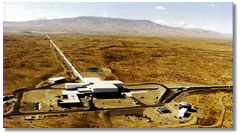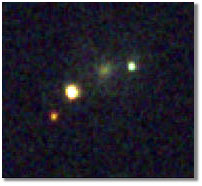 |
|
|
 |
||
|
||||||||||
|
For more information on these science news and feature story tips, contact the public information officer listed at (703) 292-8070. Editor: Amber Jones Contents of this News Tip:
LIGO Begins Hunt for Faint Ripples From Space
The search for gravitational waves reaching Earth from space will begin in earnest June 29 when the nation's foremost detector starts scientific operations. The Laser Interferometer Gravitational-Wave Observatory (LIGO), which is also the world's largest optical instrument, is expected to help scientists identify events in the universe not observable by any other means. Albert Einstein, in his general theory of relativity, predicted that gravitational waves are faint ripples in the fabric of space-time believed to be produced by the gravitational effects of black holes, collisions and other violent events. They have never been directly observed. The LIGO detectors in Livingston, La., and Hanford, Wash., are designed to detect these faint signals. Laser beams reflecting from mirrors inside the instruments will be able to measure mirror displacements as small as one-thousandth of a proton's diameter, a design goal expected to be reached within a year. LIGO's first science run is scheduled to last two weeks. The project is funded by the National Science Foundation (NSF) and headed by a team from the California Institute of Technology and Massachusetts Institute of Technology. [Amber Jones] For more information on LIGO, see: http://www.ligo.caltech.edu/ Astrophysicist Traces Gamma Rays, Receives Astronomy Honor
A recognized, NSF-supported astrophysicist has identified explosions from dying stars as the source of some gamma-ray bursts. For years astronomers have sought to confirm the cosmic source of the mysterious gamma rays that have been detected for 30 years but about which little is known. Now, Shri Kulkarni of the California Institute of Technology and colleagues have tied a gamma-ray burst directly to a supernova, or exploding massive star. Through space-based and ground-based observations, the astrophysicists detected remnants of an exploded star in the "afterglow" of a gamma-ray burst first discovered in November 2001 in a galaxy five billion light years from Earth. The results were published in the June 10 Astrophysical Journal Letters. NSF support, through Presidential Young Investigator and Alan T. Waterman awards, helped Kulkarni launch his early career - groundbreaking research in pulsars, neutron stars and gamma-ray bursts. In June, Kulkarni was named to conduct the honorary Karl G. Jansky lecture series at the NSF National Radio Astronomy Observatory. [Amber Jones] For a schedule of the Jansky lectures, see: http://www.nrao.edu U.S. and Russia Sign Agreement to Foster Materials Research CollaborationNSF and the Russian Foundation for Basic Research signed an agreement June 3 to collaborate in programs to fund materials research. The signing ceremony took place at a meeting at the Russian Academy of Science's Shubnikov Institute for Crystallography in Moscow. Representatives of the two government agencies and scientists from both countries attended. The agreement will enable jointly funded programs to benefit materials researchers both in Russia and in the United States. Scientists anticipate working out details of the program during the December 2002 meeting of the U.S. Materials Research Society in Boston, Mass., and hope to announce them in early 2003. Adriaan de Graaf, executive officer of NSF's Directorate for Physical and Mathematical Sciences, signed the agreement on behalf of the United States. According to de Graaf, the two countries intend to issue a coordinated call for proposals and conduct a coordinated proposal review. [Amber Jones] Scientists can Help Battle Terrorism, NSF Director UrgesNSF Director Rita Colwell urged scientists to apply their experience, wisdom, research and measured debate to help the nation combat terrorism in a June 19 speech to the Brookings Institution's Center for Public Policy Education. Noting that the "new era marked by the watershed events of 9/11 presents new directions for science and technology," Colwell called on scientists to help improve predictions and to apply their foresight as "a kind of early warning system-a guard against unintended consequences." "If we can predict, we frequently can prevent. . . . The research community needs to find more effective methods to use its capacity to predict to meet the real world needs through prevention," Colwell said. She also emphasized the need for a broader knowledge base. "Every discussion about airline safety, contamination by disease, failure of communication links, poisoning of food and drinking water, assessment of damaged infrastructure and countless other concerns depends on our scientific and technical knowledge," she said. She warned that narrow knowledge could become incorrect knowledge, reminding scientists that much is still unknown, and she cautioned against arrogance. Referring to the anthrax episodes of fall 2001 and her own research into cholera, Colwell noted that health threats are real and serious both abroad and at home. "Since September 11, deadly disease scenarios are no longer implausible in our own backyard," she said. Colwell emphasized the need for increased science literacy and an educated workforce to "promote good judgment" and to serve "as a strong defense against threats as well as delusions of safety." Scientists, she added, must help meet those goals. [Mary Hanson]
|
||||||||||
|
|
|
|

